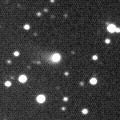
|
Although it was faint as 16.4 mag at the discovery in March (Mar. 12, R. H. McNaught), then it brightened well as expected, and now it is 11.4 mag (Sept. 25, Juan Jose Gonzalez). It is very small with a diameter of around 1 arcmin, and very strongly condensed. In the Southern Hemisphere, it keeps locating high until November while the comet is getting brighter gradually. In the Northern Hemisphere, it had kept locating very low around 15 degree high, but it will be getting higher slowly after this. However, it will be only 25 degree high at most from October to December. It will reach to 10 mag in early 2006.
Date(TT) R.A. (2000) Decl. Delta r Elong. m1 Best Time(A, h)
Oct. 1 19 29.47 -33 51.2 2.062 2.455 100 11.9 19:08 ( 4, 21)
Oct. 8 19 33.39 -32 41.5 2.083 2.388 95 11.8 18:58 ( 8, 22)
|
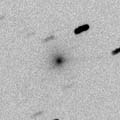
|
It was recorded as an asteroid at the discovery in 2002. It returned again now, and the faint tail was detected and it revealed to be a comet in fact. It passed very close by the earth in August, brightened rapidly from 15 mag to 12 mag. It brightened furthermore in September when appearing in the morning sky again, and reached to 10.3 mag on Sept. 14 (Juan Jose Gonzalez). It is very bright still now, 11.0 mag on Sept. 25 (Michael Jager). Although it was diffuse in August, now it seems getting strongly condensed. It is getting higher gradually after this. It will fade out rapidly after this, but it will keep bright visible visually for a while.
Date(TT) R.A. (2000) Decl. Delta r Elong. m1 Best Time(A, h)
Oct. 1 9 51.73 4 34.7 0.894 0.656 39 11.9 4:30 (278, 18)
Oct. 8 10 10.35 2 43.1 1.007 0.716 41 12.9 4:36 (281, 20)
|
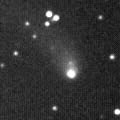
|
It was expected to reach to 9 mag in 2006 spring. But actually, it is much fainer than expected. It brightened up to 13.9 mag on Aug. 1 (Michael Mattiazzo). Then it was expected to brighten rapidly and reach to 11 mag in late September. Although it is not observable in the Northern Hemisphere, it is observable in good condition in the Southern Hemisphere. However, it is actually only 12.4 mag in October (Oct. 2, Michael Mattiazzo). It seems to be a comet with very slow brightness evolution, similar to C/2003 T4. It will be 11 mag at best. After 2006 March, it will be observable in Northern Hemisphere for a long time while it is getting fainter.
Date(TT) R.A. (2000) Decl. Delta r Elong. m1 Best Time(A, h)
Oct. 1 6 15.04 -57 40.5 2.126 2.337 89 12.2 4:30 (351, -4)
Oct. 8 6 15.74 -63 34.2 2.061 2.275 89 12.1 4:36 (356, -9)
|
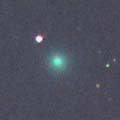
|
New comet discovered by many people in the SWAN images released in late August. It was bright as 9.5 mag visually (Aug. 25, Alan Hale). It has already passed the perihelion on Aug. 9, and it faded rapidly in September. Now it faded down to 12.2 mag (Sept. 21, Juan Jose Gonzalez). Because it is very diffused, it was reported faint around 15 mag by CCD observations. It will be higher in the morning sky after this. But it will be 13 mag in October. In the Northern Hemisphere, it must have been visible in good condition in the evening before the discovery, however, it is unobservable after this. It passed near by Owl Nebula and Galaxy M108 in late September. The excellent image by Michael Jager is published.
Date(TT) R.A. (2000) Decl. Delta r Elong. m1 Best Time(A, h)
Oct. 1 11 6.23 59 7.8 1.253 1.219 64 12.3 4:30 (216, 30)
Oct. 8 10 54.91 63 14.1 1.230 1.333 72 12.7 4:36 (213, 36)
|
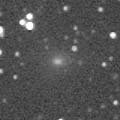
|
It reached to 11.4 mag in August (Aug. 12, Juan Jose Gonzalez). It was expected to start fading since early September. But actually, it keeps bright as 11.5 mag still on Sept. 30 (Juan Jose Gonzalez). In the Northern Hemisphere, it keeps very low in the morning until mid October, with an altitude of around 10-15 degree. Then it will be higher gradually, however, it will be fainter than 14.5 mag when the altitude becomes higher than 30 degree. In the Northern Hemisphere, it is unobservable until December.
Date(TT) R.A. (2000) Decl. Delta r Elong. m1 Best Time(A, h)
Oct. 1 11 43.07 29 38.6 1.988 1.294 34 12.6 4:30 (241, 10)
Oct. 8 11 59.56 26 6.2 2.050 1.351 34 12.9 4:36 (246, 11)
|
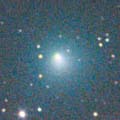
|
It kept bright as 10 mag from May to August, and it was still bright as 10.9 mag on Aug. 5 (Seiichi Yoshida). However, it has already started fading, and it faded down to 11.7 mag on Sept. 3 (Jose Carvajal). Because it is very diffused, it was reported faint around 15 mag by CCD observations. It is already very low in the evening in the Northern Hemisphere, and few observations have been reported recently. But it keeps observable in the Northern Hemisphere locating very low in the evening until December with an altitude of aroud 17 degree. In the Southern Hemisphere, it keeps locating high until November.
Date(TT) R.A. (2000) Decl. Delta r Elong. m1 Best Time(A, h)
Oct. 1 17 36.20 -31 53.8 1.656 1.735 77 13.1 19:08 ( 29, 16)
Oct. 8 17 57.56 -32 7.1 1.742 1.769 74 13.4 18:58 ( 28, 16)
|

|
It had been so faint as around 15 mag since May. It had been too faint to see visually. It was also invisible visually, fainter than 13.5 mag on Sept. 3 (Reinder J. Bouma). But an outburst occured on Sept. 9 and brightened to 13 mag (Stephane Garro). Now it is very strongly condensed.
Date(TT) R.A. (2000) Decl. Delta r Elong. m1 Best Time(A, h)
Oct. 1 2 13.64 25 2.4 4.900 5.762 146 13.2 1:36 ( 0, 80)
Oct. 8 2 10.70 24 56.1 4.852 5.763 153 13.1 1:05 ( 0, 80)
|

|
In January when it was visible in the Northern Hemisphere, it was an 11 mag small object. However, after it has gone to the southern sky, it brightened rapidly and reached to 8.0 mag from March to April (Mar. 4 and Apr. 7, Alexandre Amorim). After the perihelion passage on Apr. 10, it turned to be fading slowly. It is bright as 12.3 mag still now (Sept. 3, Reinder J. Bouma). In the Northern Hesmisphere. It keeps observable in good condition while fading gradually. The split of the nucleus was found on June 25. Both nucleus can be detected on CCD images. No effect of the split was found on the total brightness of the comet.
Date(TT) R.A. (2000) Decl. Delta r Elong. m1 Best Time(A, h)
Oct. 1 22 57.18 29 4.2 1.911 2.798 146 13.2 22:14 ( 0, 84)
Oct. 8 22 44.69 28 23.1 2.029 2.882 141 13.4 21:35 ( 0, 83)
|

|
It was bright as 7.5 mag in early January, easy to see with binoculars. However, it faded and got diffused rapidly in the evening sky after that. It faded to 10.7 mag on Mar. 15 visually (Alexandre Amorim), and 11.5 mag on Apr. 4 by CCD observation (Mitsunori Tsumura), then it became unobservable. The fading after the perihelion passage is slow. It is visible visually still now, bright as 12.8 mag (Sept. 30, Juan Jose Gonzalez). Because it is distant from the sun, it can be visible visually as 12-13 mag for a while.
Date(TT) R.A. (2000) Decl. Delta r Elong. m1 Best Time(A, h)
Oct. 1 4 6.11 -9 58.4 4.040 4.679 124 13.5 3:28 ( 0, 45)
Oct. 8 3 59.19 -10 36.2 4.031 4.748 131 13.5 2:53 ( 0, 44)
|
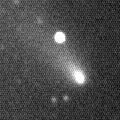
|
Although it became brightest about 2 weeks before the perihelion passage in its last appearance in 1998, it kept brightening until the perihelion passage in this return, and reached to 9.2 mag on July 2 (Carlos Labordena). After that, it faded down to 10.4 mag on Aug. 5 (Seiichi Yoshida). It must be already faint as 13 mag, but no visual observations were reported recently. It faded down to 13.7 mag on Sept. 3 by CCD observations (Ken-ichi Kadota). It will be fading while locating around 30 degree high after this in the Northern Hesmisphere.
Date(TT) R.A. (2000) Decl. Delta r Elong. m1 Best Time(A, h)
Oct. 1 8 6.27 -8 12.1 1.713 1.585 65 13.6 4:30 (307, 30)
Oct. 8 8 17.44 -10 27.4 1.726 1.648 68 13.9 4:36 (314, 32)
|
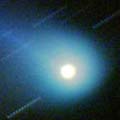
|
The brightness evolution had been slower than a typical comet since its discovery until the perihelion passage in early April. Although it had been observable only until March in the Northern Hemisphere, it has been observed continuously in the Southern Hemisphere, and it kept bright as 8 mag from mid March to mid May. It had been low until early July even in the Southern Hemisphere. The comet has faded out rapidly while locating low. No observations have been reported since mid May. However, it was observed on Aug. 1, when it was still bright as expected, 13.0 mag (Michael Mattiazzo). But no observations have been reported since that. Now it is apearing in the morning sky also in the Northern Hemisphere. But the altitude keeps very low around 10 degree until the end of 2005.
Date(TT) R.A. (2000) Decl. Delta r Elong. m1 Best Time(A, h)
Oct. 1 7 36.38 -40 12.4 2.989 2.898 75 13.6 4:30 (332, 7)
Oct. 8 7 34.68 -41 17.4 3.014 2.982 78 13.7 4:36 (339, 9)
|

|
It was fantastic, so bright as 3.5 mag, so large as 30 arcmin, locating high overhead at its best time in early January. Then it has been getting fainter and smaller gradually, 12.5 mag on Sept. 3 (Edwin van Dijk) and 13.6 mag on Sept. 30 (Katsumi Yoshimoto). The diameter is small now, about 2 arcmin, and very diffused. In the Northern Hemisphere, it keeps observable in good condition for a long time while the comet is bright enough visible visually until October when it becomes faint as 14 mag. Although it has been observable in the Northern Hemisphere for about one year since its discovery, now it is getting lower and lower. It will be too low in the evening sky in October. But it will appear again in the morning sky at 15 mag in December, then it keeps observable using CCD cameras until next summer.
Date(TT) R.A. (2000) Decl. Delta r Elong. m1 Best Time(A, h)
Oct. 1 14 56.80 8 19.0 4.265 3.538 38 13.6 19:08 ( 87, 19)
Oct. 8 15 4.58 7 12.0 4.384 3.611 35 13.8 18:58 ( 88, 16)
|
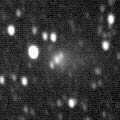
|
It kept bright as 12 mag from June to August, and it was still bright as 12.2 mag on Aug. 2 (Juan Jose Gonzalez), however, it faded down to 13.0 mag on Sept. 8 (Seiichi Yoshida). It had been very low in the Northern Hemisphere. Although it will be higher slowly after this, it is fading.
Date(TT) R.A. (2000) Decl. Delta r Elong. m1 Best Time(A, h)
Oct. 1 18 59.15 -21 42.2 1.255 1.683 95 14.0 19:08 ( 13, 32)
Oct. 8 19 16.85 -20 31.2 1.332 1.709 93 14.3 18:58 ( 14, 33)
|
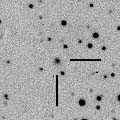
|
It brightened from 18 to 15 mag from the end of 2003 to early 2005. The brightness evolution was much faster than that of a typical comet. Although it had been too low for a while, it is getting higher again now. It was 14.9 mag on Sept. 3 (Ken-ichi Kadota), as bright as expected. It will be already visible visually around 13.5 mag.
Date(TT) R.A. (2000) Decl. Delta r Elong. m1 Best Time(A, h)
Oct. 1 9 13.43 44 56.4 5.739 5.389 64 14.3 4:30 (238, 43)
Oct. 8 9 21.20 45 3.8 5.641 5.375 69 14.2 4:36 (239, 48)
|

|
In its last appearance in 1984, it unexpectedly brightened after the perihelion passage, and reached to the maximum brightness about 45 days after the perihelion passage. In this return, it was 11.3 mag around the perihelion passage (June 16, Juan Jose Gonzalez), but it continued brightening even after that, and reached to 10.2 mag on July 2 (Juan Jose Gonzalez). However, it turned to fade out 20 days after the perihelion passage in this time. The unexpected brightening in its last appearance seems to be an exceptional outburst. It already faded down to 12.6 mag on Sept. 3 (Reinder J. Bouma). Because it is very diffused, it was reported so faint around 16-17 mag by CCD observations. It is getting lower in the evening gradually, and will be extremely low between October and November.
Date(TT) R.A. (2000) Decl. Delta r Elong. m1 Best Time(A, h)
Oct. 1 13 45.31 32 42.5 2.511 1.861 40 14.3 19:08 (118, 17)
Oct. 8 13 51.55 30 19.6 2.601 1.924 38 14.7 18:58 (117, 14)
|
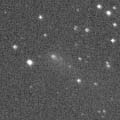
|
New comet. Although it was reported so faint as 16-20 mag by CCD observations, it is actually much brighter than the ephemeris in the public announcement. It is actually 14 mag (Sept. 24, Michael Jager). It does not look so diffuse on Michael Jager's image. It is also visible visually as 13.6 mag (Sept. 25, Werner Hasubick). It keeps observable in good condition until winter, but it will be fading gradually. It must have been observable as 15 mag in 2004 spring and summer, but it was not discovered at that time.
Date(TT) R.A. (2000) Decl. Delta r Elong. m1 Best Time(A, h)
Oct. 1 2 17.73 29 35.2 1.789 2.658 143 14.5 1:40 ( 0, 85)
Oct. 8 2 12.38 29 34.9 1.772 2.684 149 14.5 1:07 ( 0, 85)
|
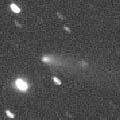
|
It was 16.8 mag at the discovery in May (May 20, R. H. McNaught). Then it brightened rapidly, and reached to 14 mag now (Aug. 2, Michael Jager). It is also visible visually as 13.7 mag (Sept. 3, Edwin van Dijk). Because it moves in the northern sky, it keeps locating high for a long time in the Northern Hemisphere. It will be visible visually at 14 mag until November.
Date(TT) R.A. (2000) Decl. Delta r Elong. m1 Best Time(A, h)
Oct. 1 4 43.48 42 34.6 0.940 1.603 111 14.7 4:05 (180, 82)
Oct. 8 4 51.39 44 48.5 0.926 1.629 115 14.8 3:45 (180, 80)
|
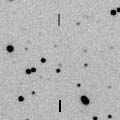
|
Appearing at dawn again. Although it was faint as 18 mag at the discovery in 2004 November, then it brightened very rapidly until early 2005, and reached to 16.0 mag on May 7 (Ken-ichi Kadota). No observations have been reported since May, but it will be as bright as 15 mag now.
Date(TT) R.A. (2000) Decl. Delta r Elong. m1 Best Time(A, h)
Oct. 1 10 54.46 22 36.2 3.143 2.387 34 15.1 4:30 (253, 16)
Oct. 8 11 9.01 21 34.3 3.105 2.392 37 15.1 4:36 (256, 19)
|
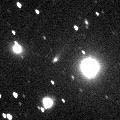
|
Although the CCD nuclear magnitude was reported so faint as 16.5-17 mag, it is actually bright as 15.7 mag (June 26, Giovanni Sostero). Sharply and strongly condensed with a narrow long tail. It will be 15 mag both in 2005 summer and 2006 summer. It moves southwards, so the condition in the Northern Hemisphere is better in 2005. It was visible visually as 13.8 mag (July 28, Seiichi Yoshida).
Date(TT) R.A. (2000) Decl. Delta r Elong. m1 Best Time(A, h)
Oct. 1 16 52.64 27 7.9 3.938 3.721 70 15.2 19:08 ( 90, 52)
Oct. 8 16 58.64 24 46.6 3.993 3.714 66 15.2 18:58 ( 89, 48)
|

|
Recovery of a peculiar asteroid 2004 FS101 discovered in 2004 spring. Although it was 18 mag in mid January, it has been brightening rather faster than a typical comet, and it reached to 16 mag in early September. It will be 14.5 mag around 2006 January. It keeps observable at 15-16 mag for a long time from 2005 spring to the end of 2006. Because it moves in the northern sky, it keeps observable for a long time in the Northern Hemisphere. However, it will be rather low when the comet becomes brightest. It was not visible visually, fainter than 14.0 mag on Aug. 5 (Seiichi Yoshida), when the altitude was high.
Date(TT) R.A. (2000) Decl. Delta r Elong. m1 Best Time(A, h)
Oct. 1 14 24.21 46 42.4 3.954 3.493 55 15.4 19:08 (128, 30)
Oct. 8 14 35.97 46 46.4 3.905 3.467 57 15.3 18:58 (129, 29)
|

|
Although it was faint as 16.4 mag in January, it brightened to 14.6 mag in May when it became at opposition (Jan. 26 and May 31, Ken-ichi Kadota). It was also visible visually as 14.3 mag (May 7, Juan Jose Gonzalez). Then it was predicted to be slightly fainter, however, it brightened furthermore visually, 13.8 mag on July 10 (Reinder J. Bouma). But on the other hand, the CCD nuclear magnitude became reported fainter, 15.5 mag in July. It is already low in the evening, and will be unobservable soon. It will be observable again as 15 mag in 2006 summer, then it will fade out.
Date(TT) R.A. (2000) Decl. Delta r Elong. m1 Best Time(A, h)
Oct. 1 16 23.48 -25 2.4 3.430 3.063 60 15.4 19:08 ( 46, 13)
Oct. 8 16 33.31 -25 29.0 3.506 3.059 55 15.4 18:58 ( 47, 11)
|
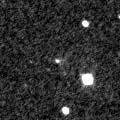
|
It was observed as 17.0 mag on July 10, as bright as expected. It was 15.1 mag on Sept. 9, brighter than this ephemeris (Yuji Ohshima). It keeps 15 mag from September to December. It can be also visible visually as around 14.5 mag.
Date(TT) R.A. (2000) Decl. Delta r Elong. m1 Best Time(A, h)
Oct. 1 0 20.88 -5 19.1 1.468 2.462 171 15.5 23:39 ( 0, 50)
Oct. 8 0 17.52 -5 50.5 1.466 2.445 165 15.5 23:08 ( 0, 49)
|
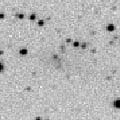
|
It was 13.6 mag on May 12, as bright as expected (Michael Mattiazzo). After that, no successful observations were reported for a while even when the comet became locating high also in the Northern Hemisphere. Actually, it was 17.1 mag on Sept. 3 (Ken-ichi Kadota). It seems the comet faded faster than expected.
Date(TT) R.A. (2000) Decl. Delta r Elong. m1 Best Time(A, h)
Oct. 1 5 24.51 10 21.1 2.056 2.528 106 16.0 4:30 (351, 65)
Oct. 8 5 25.17 10 3.8 2.010 2.570 112 16.1 4:19 ( 0, 65)
|
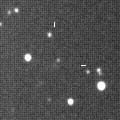
|
It will be 16 mag locating high in October and November. But it will be fainter than 18 mag at the end of 2005. It was 15.3 mag on Sept. 8, much brighter than this ephemeris (Mitsunori Tsumura). Maybe it is brightening very rapidly.
Date(TT) R.A. (2000) Decl. Delta r Elong. m1 Best Time(A, h)
Oct. 1 21 18.62 -24 13.4 0.637 1.471 126 16.2 20:37 ( 0, 31)
Oct. 8 21 20.49 -19 31.0 0.655 1.454 121 16.2 20:12 ( 0, 36)
|
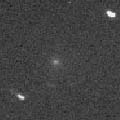
|
It was reported as 16.4 mag on Aug. 5 (Yuji Ohshima), brighter than this ephemeris. It will be observable at 16.5 mag in good condition until October.
Date(TT) R.A. (2000) Decl. Delta r Elong. m1 Best Time(A, h)
Oct. 1 3 56.00 -13 22.1 0.913 1.706 126 16.3 3:17 ( 0, 42)
Oct. 8 4 1.34 -15 19.5 0.923 1.736 129 16.4 2:55 ( 0, 40)
|

|
It brightened from 19 to 17 mag during a half of a year from summer to winter in 2004. The brightness evolution was rather faster than that of a typical comet. It had been very low for a while, but now it is getting higher again. It was 17.1 mag on Sept. 12 (Yuji Ohshima), as bright as expected. It will be observable in good condition as 16 mag for a long time until next spring.
Date(TT) R.A. (2000) Decl. Delta r Elong. m1 Best Time(A, h)
Oct. 1 9 21.00 53 2.5 5.359 5.079 68 16.5 4:30 (227, 43)
Oct. 8 9 31.39 53 26.5 5.271 5.068 72 16.5 4:36 (227, 46)
|
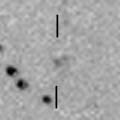
|
New comet. It was 16.8 mag on Sept. 9 (Yuji Ohshima). It keeps observable in good condition as 16.5 mag until November.
Date(TT) R.A. (2000) Decl. Delta r Elong. m1 Best Time(A, h)
Oct. 1 0 34.00 32 26.2 1.117 2.049 150 16.7 23:52 ( 0, 87)
Oct. 8 0 32.06 31 45.5 1.104 2.048 153 16.6 23:22 ( 0, 87)
|
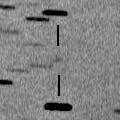
|
It was recovered at 17.3 mag on Sept. 7 (Filip Fratev), as bright as exepcted. It keeps 17.5 mag until December. Although it had been low, it will be higher after this.
Date(TT) R.A. (2000) Decl. Delta r Elong. m1 Best Time(A, h)
Oct. 1 8 57.23 17 43.8 2.097 1.749 56 17.2 4:30 (273, 37)
Oct. 8 9 15.13 17 40.1 2.053 1.760 58 17.2 4:36 (276, 40)
|

|
It reached to 17 mag in 2004 autumn. Now it is getting higher again in the morning sky. It will be observable as 17 mag in good condition in winter again.
Date(TT) R.A. (2000) Decl. Delta r Elong. m1 Best Time(A, h)
Oct. 1 7 27.33 19 29.3 3.184 3.120 77 17.4 4:30 (288, 56)
Oct. 8 7 34.00 19 3.4 3.097 3.129 82 17.4 4:36 (296, 61)
|

|
Fading slowly. It will be fainter than 12 mag. It keeps locating high.
Date(TT) R.A. (2000) Decl. Delta r Elong. m1 Best Time(A, h)
Oct. 1 1 8.95 63 48.0 5.599 6.145 118 17.4 0:31 (180, 61)
Oct. 8 0 59.45 63 17.2 5.613 6.208 122 17.5 23:49 (180, 62)
|
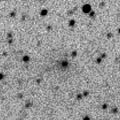
|
It will be at opposition again between autumn and winter, and observable at 17.5 mag locating high.
Date(TT) R.A. (2000) Decl. Delta r Elong. m1 Best Time(A, h)
Oct. 1 4 16.93 18 22.7 3.833 4.448 122 17.5 3:38 ( 0, 73)
Oct. 8 4 15.18 18 22.1 3.756 4.459 129 17.5 3:09 ( 0, 73)
|
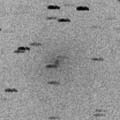
|
Although it was so faint as 17.5 mag in early May, it brightened rapidly in June while approaching to the earth down to 0.1 AU, and became visible visually as bright as 10.3 mag on June 25 (Juan Jose Gonzalez). Because it was so close to the earth, it had a very large and faint coma with a diameter of 4-8 arcmin. Surprisingly, it was detected on survey images on June 24 as a very bright and large object, 8-9 mag with a diameter of 20 arcmin (Terry Lovejoy). When it appeared again in the morning sky on Aug. 5, it was still visible visually, bright as 10.5 mag, but extremely diffuse (Seiichi Yoshida). Then it is fading out rapidly as expected, 12.5 mag on Aug. 14, and 14 mag on Sept. 1 (Michael Jager). Because it is very diffuse, it was reported so faint as 18 mag by CCD observations in mid September.
Date(TT) R.A. (2000) Decl. Delta r Elong. m1 Best Time(A, h)
Oct. 1 6 8.71 14 36.0 0.679 1.264 95 17.5 4:30 (323, 66)
Oct. 8 6 7.22 14 48.5 0.689 1.334 102 18.1 4:36 (343, 69)
|
|
![]()

 C/2005 N1 ( Juels-Holvorcem )
C/2005 N1 ( Juels-Holvorcem ) 9P/Tempel 1
9P/Tempel 1 29P/Schwassmann-Wachmann 1
29P/Schwassmann-Wachmann 1 C/2005 A1 ( LINEAR )
C/2005 A1 ( LINEAR ) C/2003 K4 ( LINEAR )
C/2003 K4 ( LINEAR ) 21P/Giacobini-Zinner
21P/Giacobini-Zinner C/2003 T4 ( LINEAR )
C/2003 T4 ( LINEAR ) C/2004 Q2 ( Machholz )
C/2004 Q2 ( Machholz ) 37P/Forbes
37P/Forbes C/2003 WT42 ( LINEAR )
C/2003 WT42 ( LINEAR ) 161P/2004 V2 ( Hartley-IRAS )
161P/2004 V2 ( Hartley-IRAS ) P/2005 R2 ( Van Ness )
P/2005 R2 ( Van Ness ) P/2005 K3 ( McNaught )
P/2005 K3 ( McNaught ) P/2004 VR8 ( LONEOS )
P/2004 VR8 ( LONEOS ) C/2005 K1 ( Skiff )
C/2005 K1 ( Skiff ) C/2005 B1 ( Christensen )
C/2005 B1 ( Christensen ) 117P/Helin-Roman-Alu 1
117P/Helin-Roman-Alu 1 101P/Chernykh
101P/Chernykh 10P/Tempel 2
10P/Tempel 2 168P/2005 N2 ( Hergenrother )
168P/2005 N2 ( Hergenrother ) C/2005 N5 ( Catalina )
C/2005 N5 ( Catalina ) C/2004 D1 ( NEAT )
C/2004 D1 ( NEAT ) P/2005 R1 ( NEAT )
P/2005 R1 ( NEAT ) 171P/2005 R3 ( Spahr )
171P/2005 R3 ( Spahr ) 119P/Parker-Hartley
119P/Parker-Hartley C/2001 Q4 ( NEAT )
C/2001 Q4 ( NEAT ) 65P/Gunn
65P/Gunn P/2005 JQ5 ( Catalina )
P/2005 JQ5 ( Catalina )![]()




























